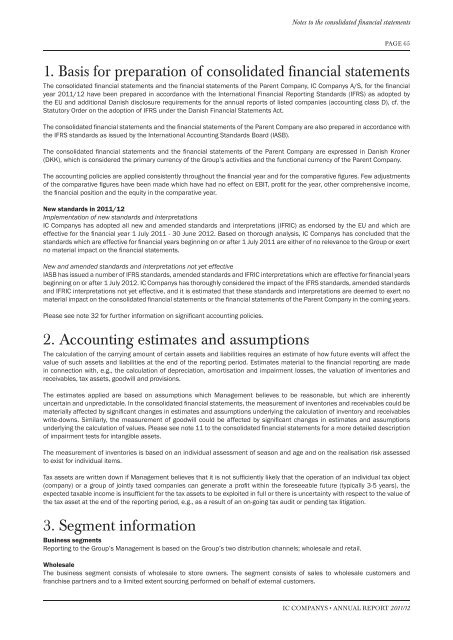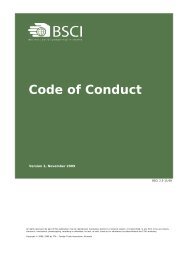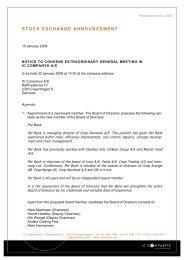ANNUAL REPORT 2011/12 - IC Companys A/S
ANNUAL REPORT 2011/12 - IC Companys A/S
ANNUAL REPORT 2011/12 - IC Companys A/S
Create successful ePaper yourself
Turn your PDF publications into a flip-book with our unique Google optimized e-Paper software.
Notes to the consolidated financial statements<br />
PAGE 65<br />
1. Basis for preparation of consolidated financial statements<br />
The consolidated fi nancial statements and the fi nancial statements of the Parent Company, <strong>IC</strong> <strong>Companys</strong> A/S, for the fi nancial<br />
year <strong>2011</strong>/<strong>12</strong> have been prepared in accordance with the International Financial Reporting Standards (IFRS) as adopted by<br />
the EU and additional Danish disclosure requirements for the annual reports of listed companies (accounting class D), cf. the<br />
Statutory Order on the adoption of IFRS under the Danish Financial Statements Act.<br />
The consolidated fi nancial statements and the fi nancial statements of the Parent Company are also prepared in accordance with<br />
the IFRS standards as issued by the International Accounting Standards Board (IASB).<br />
The consolidated fi nancial statements and the fi nancial statements of the Parent Company are expressed in Danish Kroner<br />
(DKK), which is considered the primary currency of the Group’s activities and the functional currency of the Parent Company.<br />
The accounting policies are applied consistently throughout the fi nancial year and for the comparative fi gures. Few adjustments<br />
of the comparative fi gures have been made which have had no effect on EBIT, profi t for the year, other comprehensive income,<br />
the fi nancial position and the equity in the comparative year.<br />
New standards in <strong>2011</strong>/<strong>12</strong><br />
Implementation of new standards and interpretations<br />
<strong>IC</strong> <strong>Companys</strong> has adopted all new and amended standards and interpretations (IFR<strong>IC</strong>) as endorsed by the EU and which are<br />
effective for the fi nancial year 1 July <strong>2011</strong> - 30 June 20<strong>12</strong>. Based on thorough analysis, <strong>IC</strong> <strong>Companys</strong> has concluded that the<br />
standards which are effective for fi nancial years beginning on or after 1 July <strong>2011</strong> are either of no relevance to the Group or exert<br />
no material impact on the fi nancial statements.<br />
New and amended standards and interpretations not yet effective<br />
IASB has issued a number of IFRS standards, amended standards and IFR<strong>IC</strong> interpretations which are effective for fi nancial years<br />
beginning on or after 1 July 20<strong>12</strong>. <strong>IC</strong> <strong>Companys</strong> has thoroughly considered the impact of the IFRS standards, amended standards<br />
and IFR<strong>IC</strong> interpretations not yet effective, and it is estimated that these standards and interpretations are deemed to exert no<br />
material impact on the consolidated fi nancial statements or the fi nancial statements of the Parent Company in the coming years.<br />
Please see note 32 for further information on signifi cant accounting policies.<br />
2. Accounting estimates and assumptions<br />
The calculation of the carrying amount of certain assets and liabilities requires an estimate of how future events will affect the<br />
value of such assets and liabilities at the end of the reporting period. Estimates material to the fi nancial reporting are made<br />
in connection with, e.g., the calculation of depreciation, amortisation and impairment losses, the valuation of inventories and<br />
receivables, tax assets, goodwill and provisions.<br />
The estimates applied are based on assumptions which Management believes to be reasonable, but which are inherently<br />
uncertain and unpredictable. In the consolidated fi nancial statements, the measurement of inventories and receivables could be<br />
materially affected by signifi cant changes in estimates and assumptions underlying the calculation of inventory and receivables<br />
write-downs. Similarly, the measurement of goodwill could be affected by signifi cant changes in estimates and assumptions<br />
underlying the calculation of values. Please see note 11 to the consolidated fi nancial statements for a more detailed description<br />
of impairment tests for intangible assets.<br />
The measurement of inventories is based on an individual assessment of season and age and on the realisation risk assessed<br />
to exist for individual items.<br />
Tax assets are written down if Management believes that it is not suffi ciently likely that the operation of an individual tax object<br />
(company) or a group of jointly taxed companies can generate a profi t within the foreseeable future (typically 3-5 years), the<br />
expected taxable income is insuffi cient for the tax assets to be exploited in full or there is uncertainty with respect to the value of<br />
the tax asset at the end of the reporting period, e.g., as a result of an on-going tax audit or pending tax litigation.<br />
3. Segment information<br />
Business segments<br />
Reporting to the Group’s Management is based on the Group’s two distribution channels; wholesale and retail.<br />
Wholesale<br />
The business segment consists of wholesale to store owners. The segment consists of sales to wholesale customers and<br />
franchise partners and to a limited extent sourcing performed on behalf of external customers.<br />
<strong>IC</strong> COMPANYS <strong>ANNUAL</strong> <strong>REPORT</strong> <strong>2011</strong>/<strong>12</strong>








